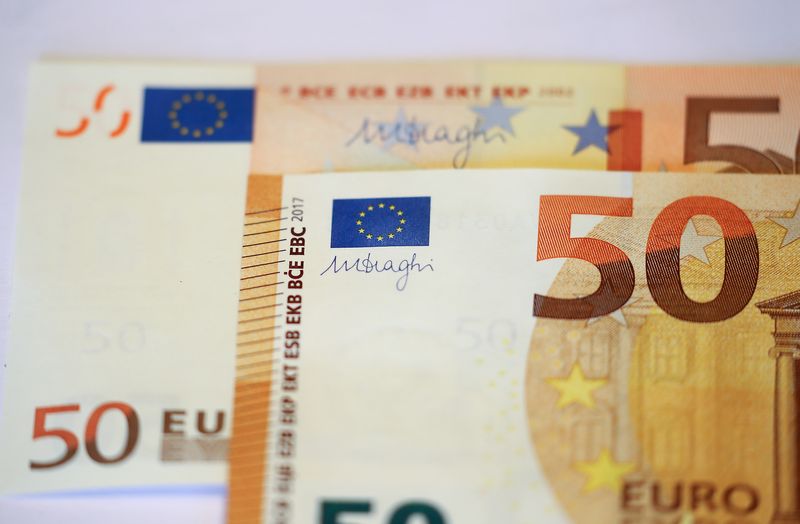NEW YORK (Reuters) – Commodity-linked currencies strengthened on Wednesday as the impact of an escalating conflict in Ukraine kept prices surging for oil and other raw materials.
The Russian rouble fell 4.5% to 106.02 against the dollar in Moscow trade. During the session, it hit a record low of 110.0, with Western sanctions following Moscow’s invasion of Ukraine pummeling Russia’s financial system. The rouble has lost about a third of its value against the dollar since the start of the year. In later trading outside of Russia, the rouble strengthened 6.61% versus the greenback at 100.10 per dollar.
The Canadian, the Australian and the New Zealand currencies were firmer as investors expected to benefit from higher commodity prices.
Crude oil futures surged above $110 a barrel, and wheat and aluminum prices jumped, with Western sanctions on Russia over its invasion of Ukraine seen disrupting Russian commodities exports.
The Aussie was 0.66% higher, the kiwi rose 0.4%, while the loonie was 0.8% higher.
“Whether or not that continues depends really on whether or not we continue to see this move higher in oil prices. That’s going to be the key to watch for especially given the fact that there’s so much uncertainty emanating from the Russia-Ukraine story,” said Bipan Rai, North American head of foreign exchange strategy at CIBC Capital Markets, in Toronto.
The U.S. dollar index, which tracks its performance against six major currencies, was last flat after hitting its highest since June 2020. The euro was last nearly unchanged against the dollar, after slipping to a 21-month low during the session.
“A continued escalation of conflict with no clear off-ramps for Russia is pulling the euro toward a test of 1.10 in the coming days,” said Shaun Osborne, chief currency strategist at Scotia Bank.
Meanwhile, the U.S. Federal Reserve will move forward with plans to raise interest rates this month to try to tame inflation, even as the outbreak of war in Ukraine has made the outlook “highly uncertain,” Fed Chair Jerome Powell said on Wednesday.
“Judging from just his testimony… it’s pretty much in line with our view that the Federal Reserve is going to hike rates at the next meeting,” Rai said.
Data showed U.S. private employers hired more workers than expected in February and data for the prior month was revised sharply higher as the labor market recovery gathered steam.
The Canadian currency extended gains after the Bank of Canada raised interest rates by 25 basis points to 0.50% in its first hike since October 2018, and said it would continue with the reinvestment phase of its bond buying program.
A modest pick-up in investors’ appetite for riskier currencies kept the safe-haven Swiss franc and the Japanese yen pressured, with the dollar rising 0.2% against the franc and up 0.5% against the yen.
Bitcoin was down 0.31%.
========================================================
Currency bid prices at 4:15PM (2115 GMT)
Description RIC Last U.S. Close Pct Change YTD Pct High Bid Low Bid
Previous Change
Session
Dollar index
97.3290 97.3160 +0.03% 1.742% +97.8340 +97.2800
Euro/Dollar
$1.1122 $1.1124 -0.01% -2.16% +$1.1145 +$1.1058
Dollar/Yen
115.5200 114.9100 +0.53% +0.35% +115.6850 +114.7900
Euro/Yen
128.50 127.83 +0.52% -1.40% +128.7600 +127.3100
Dollar/Swiss
0.9202 0.9188 +0.15% +0.88% +0.9239 +0.9167
Sterling/Dollar
$1.3405 $1.3328 +0.57% -0.89% +$1.3406 +$1.3275
Dollar/Canadian
1.2636 1.2748 -0.86% -0.05% +1.2744 +1.2628
Aussie/Dollar
$0.7296 $0.7253 +0.60% +0.37% +$0.7306 +$0.7245
Euro/Swiss
1.0234 1.0219 +0.15% -1.29% +1.0263 +1.0160
Euro/Sterling
0.8295 0.8343 -0.58% -1.25% +0.8360 +0.8295
NZ
Dollar/Dollar $0.6789 $0.6763 +0.43% -0.77% +$0.6799 +$0.6745
Dollar/Norway
8.8385 8.9000 -0.59% +0.43% +8.9585 +8.8410
Euro/Norway
9.8348 9.8822 -0.48% -1.78% +9.9170 +9.8217
Dollar/Sweden
9.6694 9.6277 +0.25% +7.22% +9.7664 +9.6253
Euro/Sweden
10.7516 10.7246 +0.25% +5.06% +10.8063 +10.7244
(Reporting by Saqib Iqbal Ahmed and Caroline Valetkevitch; Editing by Tomasz Janowski)
























